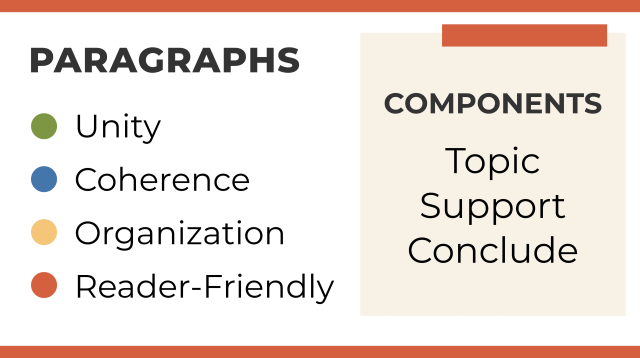
Paragraph Construction
 In this lesson, we will look into the art of constructing effective paragraphs. Well-structured paragraphs are the building blocks of coherent and organized writing. By the end of this lesson, you will have a clear understanding of how to create paragraphs that convey your ideas logically and persuasively.
In this lesson, we will look into the art of constructing effective paragraphs. Well-structured paragraphs are the building blocks of coherent and organized writing. By the end of this lesson, you will have a clear understanding of how to create paragraphs that convey your ideas logically and persuasively.
Understanding the Role of Paragraphs
Before we dive into the specifics of constructing paragraphs, let’s grasp the fundamental role they play in your writing:
Unity: Each paragraph should have a single central idea or main point. This helps maintain clarity and prevents confusion for your readers.
Coherence: Your ideas within a paragraph should be logically connected. Sentences should flow smoothly, creating a coherent narrative.
Organization: Paragraphs provide structure to your writing. They allow you to break down your ideas into manageable sections.
Reader-Friendly: Well-constructed paragraphs make it easier for your audience to follow your argument or narrative.
Components of a Paragraph
A well-constructed paragraph typically consists of three main components:
- Topic Sentence: This is the heart of your paragraph. It introduces the main idea or point you want to convey. A strong topic sentence is clear, concise, and often appears at the beginning of the paragraph.
Example: The importance of renewable energy sources in mitigating climate change cannot be overstated.
- Supporting Sentences: These sentences provide evidence, examples, or elaboration that supports the topic sentence. They expand on the main idea and offer context.
Example: Solar power, wind turbines, and hydropower are all sustainable alternatives that can reduce our reliance on fossil fuels.
- Concluding Sentence (optional): While not all paragraphs require a concluding sentence, it can be useful to provide closure or transition to the next paragraph.
Example: Incorporating these technologies into our energy infrastructure is crucial for a sustainable future.
Structuring a Paragraph
To create an effective paragraph, follow this general structure:
- Begin with a Topic Sentence: Clearly state the main idea you intend to discuss in the paragraph.
- Provide Supporting Details: Use one or more sentences to expand on the topic sentence. Offer evidence, examples, statistics, or anecdotes to support your point.
- Maintain Coherence: Ensure that each sentence logically follows the previous one. Use transitional words and phrases to guide your readers through your paragraph.
- Conclude (if needed): If your paragraph requires a concluding sentence, use it to summarize the main point or transition to the next idea.
Paragraph construction is a critical skill for any writer. In the upcoming quiz, we will write several imaginative essay questions to practice writing paragraphs.
